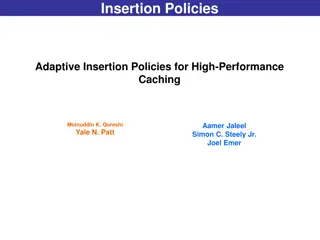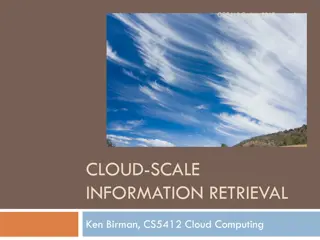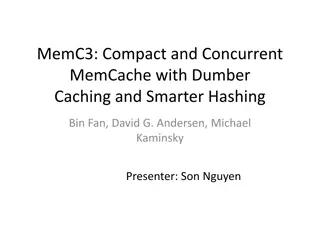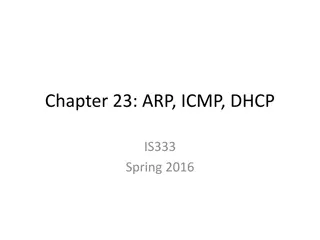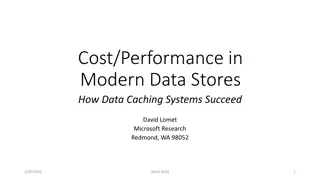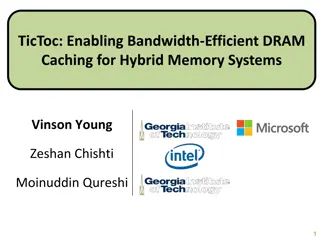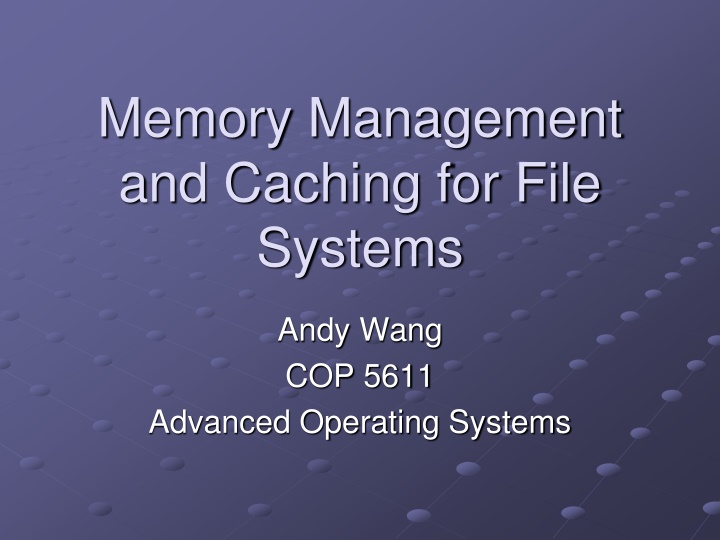
Memory Management and Caching for File Systems - Address Translation in Operating Systems
Learn about memory management, caching, and address translation in operating systems. Explore topics like virtual addresses, translation schemes, base-and-bound translation, and the pros and cons involved. Dive into the complexities of managing memory and optimizing file systems efficiently.
Download Presentation

Please find below an Image/Link to download the presentation.
The content on the website is provided AS IS for your information and personal use only. It may not be sold, licensed, or shared on other websites without obtaining consent from the author. If you encounter any issues during the download, it is possible that the publisher has removed the file from their server.
You are allowed to download the files provided on this website for personal or commercial use, subject to the condition that they are used lawfully. All files are the property of their respective owners.
The content on the website is provided AS IS for your information and personal use only. It may not be sold, licensed, or shared on other websites without obtaining consent from the author.
E N D
Presentation Transcript
Memory Management and Caching for File Systems Andy Wang COP 5611 Advanced Operating Systems
Prelude on Memory Addresses Memory is byte-addressable Each memory address can specify the location of a byte unsigned char memory[MEMORY_SIZE] To access memory[virtual_memory_address]
Address Translation Each process is associated with an address space, or all the physical addresses a process can touch However, each process believes that it owns the entire memory, starting with the virtual address 0 The missing piece is a translation table Translate every memory reference from virtual to physical addresses
Address Translation Visualized Translation table Virtual addresses Physical addresses Data reads or writes (untranslated)
This Lecture Different translation schemes Base-and-bound translation Segmentation Paging Multi-level translation Paged page tables Hashed page tables Inverted page tables
Assumptions 32-bit machines 1-GB RAM max
Base-and-Bound Translation Each process is loaded into a contiguous region of physical memory Processes are protected from one another Base Virtual address + Physical address > Error Bound
Base-and-Bound Translation Each process thinks that it owns a dedicated machine, with memory addresses from 0 to bound Virtual addresses Physical addresses 0 base = 6250 code data stack code data stack bound 6250 + bound
Base-and-Bound Translation An OS can move a process around By copying bits Changing the base and bound registers
Pros/Cons of Base-and-Bound Translation + Simplicity + Speed - External fragmentation: memory wasted because the available memory is not contiguous for allocation - Difficult to share programs Each instance of a program needs to have a copy of the code segment
External Fragmentation external fragmentation
Pros/Cons of Base-and-Bound Translation - Memory allocation is complex Need to find contiguous chunks of free memory First fit: Use the first free memory region that is big enough Best fit: Use the smallest free memory region Worst fit: Use the largest free memory region Reorganization involves copying - Does not work well when address spaces grow and shrink dynamically
Segmentation Segment: a logically contiguous memory region Segmentation-based translation: use a table of base-and-bound pairs
Segmentation Illustrated Virtual addresses Physical addresses 0x0 0x0 data code 0x4ff 0x6ff 0x1000 data 0x14ff 0x2000 stack 0x2fff 0x3000 stack 0x3fff 0x4000 code 0x46ff
Segmentation Diagram 30 bits up to 30 bits Physical seg base Seg bound 22 entries Physical seg base Seg bound Physical seg base Seg bound up to 30 bits Virt seg # Offset + Phy addr log2(1GB) = 30 bits for 1GB of RAM 32 - 30 = 2 bits for 32-bit machines Error >
Segmentation Diagram 00 code 0x4000 0x700 data 01 0x0 0x500 10 stack 0x2000 0x1000 2 0x80000200 + 0x2200 1000 0000 0000 0000 0000 0010 0000 0000 >
Segmentation Diagram 00 code 0x4000 0x700 data 01 0x0 0x500 10 stack 0x2000 0x1000 2 0x40000100 + ? >
Segmentation Diagram 00 code 0x4000 0x700 data 01 0x0 0x500 10 stack 0x2000 0x1000 2 0x00000800 + ? >
Segmentation Translation virtual_address = virtual_segment_number:offset physical_base_address = segment_table[virtual_segment_number] physical_address = physical_base_address + offset
Pros/Cons of Segmentation + Easier to grow/shrink individual segments + Finer control of segment accesses e.g., read-only for shared code segment Recall the semantics of fork() + More efficient use of physical space + Multiple processes can share the same code segment - Memory allocation is still complex Requires contiguous allocation
Paging Paging-based translation: memory allocation via fixed-size chunks of memory, or pages Uses a bitmap to track the allocation status of memory pages Translation granularity is a page
Paging Illustrated Virtual addresses Physical addresses 0x0 0x0 0x1000 0x1000 0x2000 0x2000 0x3000 0x3000 0x3fff 0x4000
Paged Memory Acces unsigned char memory[N_PAGES][PAGE_SIZE] To access memory[virtual_page_number][page_offset]
Paging Diagram 32 12 = 20 bits for 32-bit machines log2(4KB) = 12 bits for 4-KB pages Virtual page number Offset Page table size > Physical page number 220 entries Physical page number Physical page number Physical page number Offset Error log2(1GB) = 30 bits for 1GB of RAM
Paging Example 0000 0000 0000 0000 0000 0100 0000 0000 0x00000400 0 2 > 0 00004 0000 1 00000 0001 0010 2 00002 0x00004400 4
Paging Example 0x00001200 0 2 > 0 00004 0000 1 00000 0001 0010 2 00002 4 ?
Paging Example 0x00002500 0 2 > 0 00004 0000 1 00000 0001 0010 2 00002 4 ?
Paging Translation virtual_address = virtual_page_number:offset physical_page_number = page_table[virtual_page_number] physical_address = physical_page_number:offset
Pros and Cons of Paging + Easier memory allocation + Allows code sharing - Internal fragmentation: allocated pages are not fully used - Page table can potentially be very large 32-bit architecture with 1-KB pages can require 4M table entries
Fragmentation Analogies Internal fragmentation External fragmentation
Multi-Level Translation Segmented-paging translation: breaks the page table into segments Paged page tables: Two-level tree of page tables
Segmented Paging 30 bits for 1-GB RAM 32 - 3 - 12 = 17 bits Page table base Page table bound 23 entries Page table base Page table bound Page table base Page table bound 12 bits for 4-KB pages 18 bits num of entries defined by bound; up to 217 entries Seg # Virt page # Offset Phy page # Phy page # + log2(6 segments) = 3 bits Phy page # Error >
Segmented Paging 32 3 12 = 17 bits 217 Seg # Virt page # Offset Page table size > Phy page # Phy page # Phy page # Phy page # Offset Error log2(1GB) = 30 bits for 1GB of RAM
Segmented Paging Example Page table segment starting address Number of page table entries Page table segment number 0x00000000 0x16 000 001 0x00003000 0x1000 010 0x50000000 0x20 0x20002003 0x00003000 001 Phy page # 00 0010 0011 Phy page # + 0 0000 0000 0000 0010 Phy page # 0000 0000 0011 Error >
Segmented Paging 0x20002003 001 0x1000 0010 0011 0 0000 0000 0000 0010 0000 0000 0011 > Page table Entry number 0x70000 00 01 0x70004 10 0x70008 0x70008 0x003 Error
Segmented Paging Example Page table segment starting address Number of page Table entries Page table segment number 0x00000000 0x16 000 001 0x00003000 0x1000 010 0x50000000 0x20 0x21002005 0x00003000 ? ? ? Phy page # Phy page # + ? ? Phy page # Error >
Segmented Paging Example Page table segment starting address Number of page Table entries Page table segment number 0x00000000 0x16 000 001 0x00003000 0x1000 010 0x50000000 0x20 0x21002005 0x00003000 001 Phy page # 0101 Phy page # + 0 0001 0000 0000 0010 Phy page # 0000 0000 0101 Error >
Segmented Paging Translation virtual_address = segment_number:page_number:offset page_table = segment_table[segment_number] physical_page_number = page_table[virtual_page_number] physical_address = physical_page_number:offset
Pros/Cons of Segmented Paging + Code sharing + Reduced memory requirements for page tables - Higher overhead and complexity - Page tables still need to be contiguous - Two lookups per memory reference
Paged Page Tables 12 bits 12 bits for 4-KB pages Page table num Virt page num Offset Page table address (30 bits) 212 entries Page table address Page table address Phy page num 28 entries Phy page num Phy page num Phy page num (18 bits) Offset
Paged Page Table Translation virtual_address = page_table_num:virtual_page_num:offset page_table = page_table_address[page_table_num] physical_page_num = page_table[virtual_page_num] physical_address = physical_page_num:offset
Pros/Cons of Paged Page Tables + Can be generalized into multi-level paging - Multiple memory lookups are required to translate a virtual address Can be accelerated with translation lookaside buffers (TLBs) Store recently translated memory addresses for short-term reuses
Hashed Page Tables Physical_address = hash(virtual_page_num):offset + Conceptually simple - Need to handle collisions - Need one hash table per address space
Inverted Page Table One hash entry per physical page physical_address = hash(pid, virtual_page_num):offset + The number of page table entries is proportional to the size of physical RAM - Collision handling
Caching Stores copies of data at places that can be accessed more quickly than accessing the original Speeds up access to frequently used data At a cost: slows down the infrequently used data
Caching in Memory Hierarchy Provides the illusion of TB storage With register access time Access Time 1 clock cycle 1-2 clock cycles Size Cost Primary memory Registers Cache (L1/L2) ~500 bytes < 10 MB On chip Main memory SSD Disk 1-4 clock cycles 25-100 sec 5-10 msec < 64 GB < 2 TB < 16 TB $3/GB $60/TB $10/TB Secondary memory
Caching in Memory Hierarchy Exploits two hardware characteristics Smaller memory provides faster access times Large memory provides cheaper storage per byte Puts frequently accessed data in small, fast, and expensive memory Assumption: non-random program access behaviors
Locality in Access Patterns Temporal locality: recently referenced locations are more likely to be referenced soon e.g., files Spatial locality: referenced locations tend to be clustered e.g., listing all files under a directory
Caching Does not work well for programs with little localities e.g., scanning the entire disk Leaves behind cache content with no localities (cache pollution)
Generic Issues in Caching Effective metrics Cache hit: a lookup is resolved by the content stored in cache Cache miss: a lookup is resolved elsewhere Effective access time = P(hit)*(hit_cost) + P(miss)*(miss_cost)





